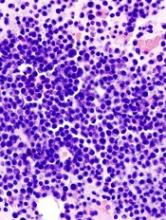The E-selectin antagonist GMI-1271 can restore sensitivity to bortezomib in resistant multiple myeloma (MM), according to preclinical research published in Leukemia.
Researchers found evidence to suggest that E-selectin ligands induce an aggressive form of MM that is resistant to treatment with bortezomib.
However, treatment with GMI-1271 was able to overcome this resistance in a mouse model of the disease.
“The results in this preclinical study demonstrate that targeting E-selectin may provide a novel approach to treatment of patients with multiple myeloma and could potentially restore sensitivity to chemotherapy and, in particular, proteasome inhibitor therapy,” said John L. Magnani, PhD, vice-president and chief scientific officer of GlycoMimetics Inc., the company developing GMI-1271.
This research was supported by GlycoMimetics, and some of the researchers involved are employees of the company.
The researchers noted that E-selectin ligands are recognized by an antibody known as HECA452. So the team screened 9 MM cell lines for E-selectin ligands using HECA452.
Most of the cell lines were negative for HECA452. However, a minority of cells in 2 of the cell lines—11.2% of RPMI8226 cells and 2.4% of MM1S cells—were positive for HECA452.
So the researchers established HECA452-enriched cell lines from the RPMI8226 and MM1S cells to investigate the biology of E-selectin ligands in MM.
The team said they found that “HECA452-enriched cells express functional E-selectin ligands and exhibit enhanced rolling and adhesion capabilities on E-selectin, which are amenable to therapeutic intervention.”
Experiments in mice
To build on their in vitro findings, the researchers compared the effects of parental MM1S cells and HECA452-enriched MM1S cells in mice.
The team found that animals transplanted with HECA452-enriched cells had significantly shorter survival than those transplanted with parental MM1S cells.
The researchers said this difference is unlikely to be due to a different proliferation rate between the 2 cell types because they demonstrated comparable proliferation and clonogenic capacity in vitro.
The team then tested treatments in a second cohort of mice transplanted with parental or HECA452-enriched MM1S cells. The mice received saline, GMI-1271 alone, bortezomib alone, or GMI-1271 plus bortezomib.
In mice with parental MM1S cells, the median survival was 33 days in the saline group, 31 days in the GMI-1271 group, 42 days in the bortezomib group (P=0.0622 vs saline), and 60 days in the GMI-1271 plus bortezomib group (P=0.0101 vs saline, P=0.0363 vs bortezomib alone).
In mice with HECA452-enriched MM1S cells, the median survival was 25.5 days in the saline group, 30 days in the GMI-1271 group, 24 days in the bortezomib group (P=0.6743 vs saline), and 56.5 days in the GMI-1271 plus bortezomib group (P=0.0028 vs saline, P=0.0123 vs bortezomib alone).
The researchers said additional experiments in mice revealed that GMI-1271 mobilizes HECA452-positive human MM cells from the bone marrow into the peripheral blood.
Investigation in patients
Finally, the researchers evaluated the role of E-selectin and its ligands in patients with MM.
The team looked for HECA452-positive plasma cells in bone marrow samples from MM patients and found these cells were more common in patients with relapsed or refractory MM (14/50) than in those with newly diagnosed MM (1/33, P=0.009).
Next, the researchers analyzed RNA sequencing data from the CoMMpass study and found that increased expression of genes involved in E-selectin ligand synthesis (ST3Gal-6 or ST3Gal-4 and FUT7) is associated with poor progression-free survival (hazard ratio=1.37, P=0.02).
The team concluded that their results “provide compelling evidence that E-selectin and its ligands play an important role in disease progression and drug resistance in MM.” And there is “a strong rationale” for targeting E-selectin and its ligands in patients with MM.


